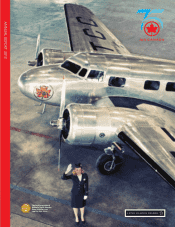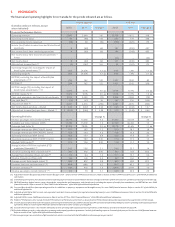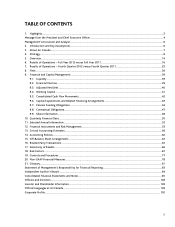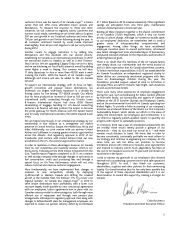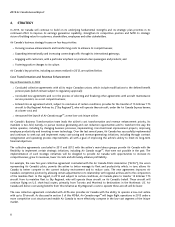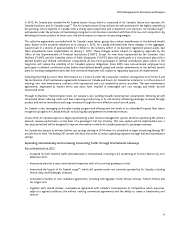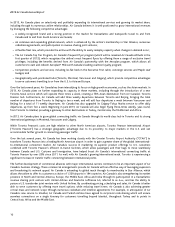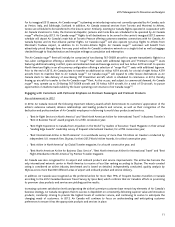Air Canada 2012 Annual Report Download - page 9
Download and view the complete annual report
Please find page 9 of the 2012 Air Canada annual report below. You can navigate through the pages in the report by either clicking on the pages listed below, or by using the keyword search tool below to find specific information within the annual report.
2012 Management’s Discussion and Analysis
9
In 2012, Air Canada also created the Air Canada Leisure Group, which is comprised of Air Canada’s leisure tour operator, Air
Canada Vacations, and Air Canada rougeTM. The Air Canada Leisure Group will also be well positioned in the highly competitive,
but growing, leisure segment in Canada, with a strong value proposition and competitive cost structure. Air Canada rougeTM
will operate under the principle of maintaining a long-term cost structure consistent with that of its low-cost competitors. By
delivering its leisure product at lower costs, the airline expects to improve its operating margins.
The collective agreements concluded with Air Canada’s main labour groups also contain amendments to the defined benefit
plans. Based on the actuarial valuations as at January 1, 2012, Air Canada estimated that these changes, in the aggregate,
would result in a decline of approximately $1.1 billion to the solvency deficit in its domestic registered pension plans, had
these amendments been implemented on January 1, 2012. These changes remain subject to regulatory approvals by the
Office of the Superintendent of Financial Institutions (“OSFI”). Except for new hires represented by the Canadian Auto
Workers (“CAW”) and the Canadian Union of Public Employees (“CUPE”) (who will participate in a new pension plan with a
defined benefit and defined contribution component), all new hires participate in defined contribution plans which, in the
long-term, will reduce the volatility of Air Canada’s pension obligations. Since 2005, new non-unionized employee hires
participate in defined contribution plans (rather than defined benefit plans) and similar amendments to the defined benefit
plans for existing management and other non-unionized employees will, subject to regulatory approval, be implemented.
Following the filing by Aveos Fleet Performance Inc. (“Aveos”) under the Companies’ Creditors Arrangement Act (“CCAA”) and
the termination of all maintenance agreements between Air Canada and Aveos, Air Canada has entered, or is in the process of
entering, into new maintenance contracts with experienced and cost competitive service providers. The new maintenance
agreements, negotiated at market terms and rates, have resulted in meaningful unit cost savings and better aircraft
turnaround times.
Through its Business Transformation team, Air Canada is also working towards lowering fuel consumption; bettering aircraft
turnaround times; reducing credit card fees; improving productivity in its call centres; enhancing passenger revenues through
product and service innovations and cargo revenues through the more effective use of aircraft space.
Air Canada is also leveraging its Aeroplan loyalty program and offering new tier levels in its rebranded frequent flyer status
recognition program, Air Canada Altitude, to build loyalty and generate incremental revenues.
In late 2013, Air Canada expects to begin implementing a new revenue management system aimed at optimizing the airline’s
network revenue performance on the basis of a passenger’s full trip itinerary. This new system will be implemented over a
two-year period and will be designed to improve the manner in which Air Canada optimizes its passenger revenues.
Air Canada also expects to achieve further cost savings starting in 2014 when it is scheduled to begin introducing Boeing 787
aircraft into its fleet. The Boeing 787 aircraft will allow the airline to reduce operating expenses through fuel and maintenance
savings.
Expanding internationally and Increasing Connecting Traffic through International Gateways
Key achievements in 2012
Increased its sixth freedom traffic (international to international, including U.S.) connecting at Toronto Pearson by over
20% from 2011;
Announced plans for a major international expansion with a focus on key gateways to Asia;
Announced the launch of Air Canada rougeTM, which will operate routes not currently operated by Air Canada, including
Venice, Italy, and Edinburgh, Scotland;
Concluded a number of new codeshare agreements, including with Egyptair, South African Airways, Turkish Airlines and
Aer Lingus; and
Together with United Airlines, concluded an agreement with Canada's Commissioner of Competition which preserves,
subject to agreed conditions, the airlines' existing commercial agreements and the ability to create a transborder joint
venture.

